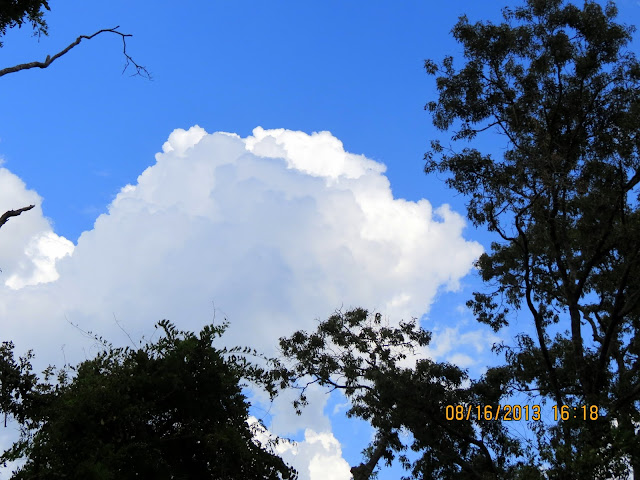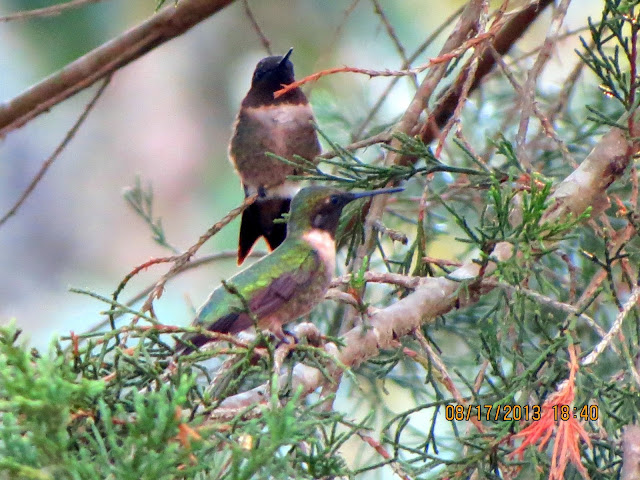Hi Everybody!!
I could see from the window clouds were bubbling up into white mountains, so I went out to see if one was a rain cloud with my name on it! Just goes to show You that You may go out with one thing on your mind and discover something else instead! While scanning the sky for my rain cloud, I spotted a spotted bird! Wow oh wow!!! A baby Mississippi Kite (juvenile). These photos in your photostudy tonight confirm that the Kites are breeding here on my Rainbow Creek. Citizen sightings and documentation like mine help the Scientists learn more about the range of species as well as many other things like my focus: behavior.
For example, I do not have one picture of one beautiful baby Kite. I have a photo history of all the Kites in this area since they arrived in Spring, via this Nature Blog. I encourage all of You to document the living things in your area (and put it online) to help in the effort to better understand all life on Earth. So a little stroll through my beautiful clouds on this day-then on to the Feature Attraction of the baby Kite! Enjoy!
Hello World, I am new on Earth. I am a Kite!
http://en.wikipedia.org/wiki/Mississippi_Kite
Mississippi Kite
From Wikipedia, the free encyclopedia
The Mississippi Kite (Ictinia mississippiensis) is a small bird of prey in the family Accipitridae. It is 12 to 15 inches (30–37 cm) beak to tail and has a wingspan averaging 3 feet (91 cm). Weight is from 214 to 388 grams (7.6-13.7 oz).[1] Adults are gray with darker gray on their tail feathers and outer wings and lighter gray on their heads and inner wings. Males and females look alike, but the males are slightly paler on the head and neck. Young kites have banded tails and streaked bodies.[2] Mississippi Kites have narrow, pointed wings and are graceful in flight, often appearing to float in the air. It is not uncommon to see several circling in the same area. Their diet consists mostly of insects which they capture in flight. They eat cicada, grasshoppers, and other crop-damaging insects, making them economically important. They have also been known to eat small vertebrates, including amphibians, reptiles, mammals, and occasionally birds. Their call is a high-pitched squeak, sounding similar to that of a squeaky dog toy.
Mississippi Kites breed across the central and southern United States. Breeding territory has expanded in recent years and Mississippi Kites have been regularly recorded in the southern New England states and a pair has successfully raised young as far north as Newmarket, New Hampshire.[3] They migrate to southern subtropicalSouth America in the winter. Mississippi Kites usually lay two white eggs (rarely one or three) in twig nests that rest in a variety of deciduous trees. In the past 75 years, they have undergone changes in nesting habitat from use of forest and savanna to include shelterbelts and are now very common nesters in urban area that are highly populated in the western south-central states.
Mississippi kites nest in colonies and both parents (paired up before arriving at the nesting site) incubate the eggs and care for the young.[4] They have one clutch a year which takes 30 to 32 days to hatch. The young birds leave the nest another 30 to 35 days after hatching. Only about half of kites successfully raise their young. Clutches fall victim to storms and predators such as raccoons and Great Horned Owls. Because of the reduced amount of predators in urban areas, Mississippi Kites produce more offspring in urban areas than rural areas. They have an average lifespan of 8 years.

http://en.wikipedia.org/wiki/File:Juvikite.jpg
Summary[edit]
| Description |
English: Juvenile Mississippi Kite, southwest Oklahoma
|
| Date | 09/06/2008 |
| Source | Own work |
| Author | Rescuechick |
| This file is licensed under the Creative Commons Attribution 3.0 Unported license. | |
|
Now back to my tree:
Here, he is waving Hello!
He is on top of tall branch of dead tree
Blue Althea Tree Flower just opening for the day:
...this is brendasue signing off from Rainbow Creek. See You next time! The fall migration for the Ruby Throated Hummingbird is in progress!!!! They are coming in. At first they stay high in the tall trees. They are beginning to choose the feeders they will guard. And, the chase is on! They are wooshing through the yard at the speed of light chasing each other. I got a few in the hiding places. They are hard to see in the trees!
a couple of entries from Google Index today:
Migration Basics - Hummingbirds.net
www.hummingbirds.net/migration.html
Most Ruby-throated Hummingbirds winter between southern Mexico and northern Panama. Since hummingbirds lead solitary lives and neither live nor migrate ...
Ruby-throated Hummingbird - Wikipedia, the free encyclopedia
en.wikipedia.org/wiki/Ruby-throated_Hummingbird
The Ruby-throated Hummingbird (Archilochus colubris) is a species of hummingbird. As with all ... In late summer to early fall they fatten up for migration. This is ...PLEASE SEE GOOGLE INDEX FOR COMPLETE LIST
O+O

























































































No comments:
Post a Comment
Hi Everybody! Please say hello and follow so I know you are here! Due to the inconsideration of people trying to put commercials on my blog comment area, I have restricted use of anonymous posts. Sorry that some hurt all.
My public email is katescabin@gmail.com No spammers or trolls